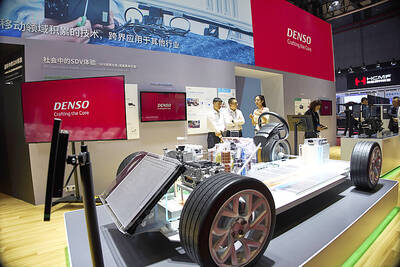Fingerprint sensor designer Egis Technology Inc (神盾) yesterday said that it has filed a patent infringement lawsuit with Beijing’s Intellectual Property Court against Chinese rival Goodix Technology Inc (匯頂) in a renewed legal battle.
Egis in a statement said that Goodix has infringed on its property rights by using its patent in the manufacturing and sales of fingerprint products without Egis’ permission.
The company has requested the court to immediately stop Goodix’s practice and destroy all problematic products. It is also seeking 90 million yuan (US$13.24 million) in damages, the statement said.
Egis chief operating officer and chief technology officer Todd Lin (林功藝) confirmed the lawsuit, saying on the sidelines of an industry event in Taipei that Goodix has infringed upon Egis’ optical fingerprint patent and algorithm.
Egis said that it has allocated significant resources to develop new technology and products.
Based on its annual report, the company last year spent about 20 percent of its total revenue on research and development in a bid to offer competitive fingerprint sensors used in mobile devices and other electronics.
The company, which counts Samsung Electronics Co as its biggest client, has been expanding its presence in the Chinese market and has gained more Chinese customers, including supplying fingerprint sensors for Huawei Technologies Co’s (華為) premium and 5G phones.
The lawsuit is the latest legal dispute between Egis and Goodix.
Shenzhen-based Goodix is a subsidiary of MediaTek Inc (聯發科) and the world’s largest fingerprint sensor supplier.
It filed a lawsuit with the Beijing Intellectual Property Court in July last year, alleging that Egis contravened intellectual property rights by using its patent to make optical fingerprint sensors that are incorporated under displays of mobile phones.
The court in February ruled that the patent was invalid and overruled Goodix’s complaint in March.
MediaTek, Taiwan’s biggest handset chip designer, has said that it plans to reduce its stake in Goodix from 9.29 percent to 7.29 percent between July 10 and Jan. 5 next year.

GROWING OWINGS: While Luxembourg and China swapped the top three spots, the US continued to be the largest exposure for Taiwan for the 41st consecutive quarter The US remained the largest debtor nation to Taiwan’s banking sector for the 41st consecutive quarter at the end of September, after local banks’ exposure to the US market rose more than 2 percent from three months earlier, the central bank said. Exposure to the US increased to US$198.896 billion, up US$4.026 billion, or 2.07 percent, from US$194.87 billion in the previous quarter, data released by the central bank showed on Friday. Of the increase, about US$1.4 billion came from banks’ investments in securitized products and interbank loans in the US, while another US$2.6 billion stemmed from trust assets, including mutual funds,

AI TALENT: No financial details were released about the deal, in which top Groq executives, including its CEO, would join Nvidia to help advance the technology Nvidia Corp has agreed to a licensing deal with artificial intelligence (AI) start-up Groq, furthering its investments in companies connected to the AI boom and gaining the right to add a new type of technology to its products. The world’s largest publicly traded company has paid for the right to use Groq’s technology and is to integrate its chip design into future products. Some of the start-up’s executives are leaving to join Nvidia to help with that effort, the companies said. Groq would continue as an independent company with a new chief executive, it said on Wednesday in a post on its Web

Even as the US is embarked on a bitter rivalry with China over the deployment of artificial intelligence (AI), Chinese technology is quietly making inroads into the US market. Despite considerable geopolitical tensions, Chinese open-source AI models are winning over a growing number of programmers and companies in the US. These are different from the closed generative AI models that have become household names — ChatGPT-maker OpenAI or Google’s Gemini — whose inner workings are fiercely protected. In contrast, “open” models offered by many Chinese rivals, from Alibaba (阿里巴巴) to DeepSeek (深度求索), allow programmers to customize parts of the software to suit their

JOINT EFFORTS: MediaTek would partner with Denso to develop custom chips to support the car-part specialist company’s driver-assist systems in an expanding market MediaTek Inc (聯發科), the world’s largest mobile phone chip designer, yesterday said it is working closely with Japan’s Denso Corp to build a custom automotive system-on-chip (SoC) solution tailored for advanced driver-assistance systems and cockpit systems, adding another customer to its new application-specific IC (ASIC) business. This effort merges Denso’s automotive-grade safety expertise and deep vehicle integration with MediaTek’s technologies cultivated through the development of Media- Tek’s Dimensity AX, leveraging efficient, high-performance SoCs and artificial intelligence (AI) capabilities to offer a scalable, production-ready platform for next-generation driver assistance, the company said in a statement yesterday. “Through this collaboration, we are bringing two